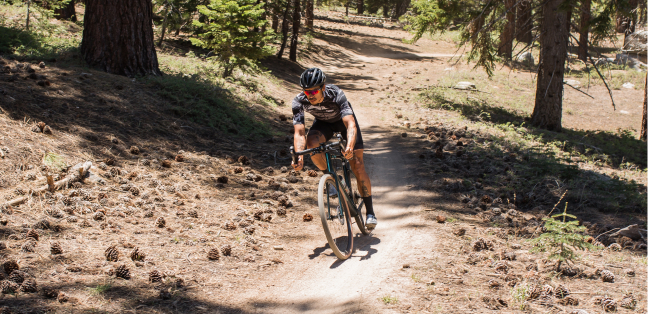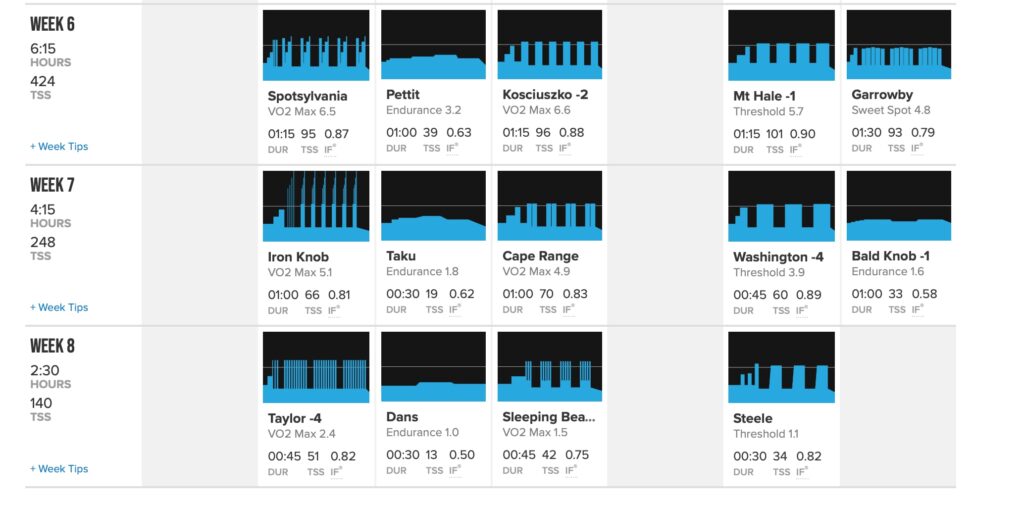Tapering and Peaking for Cyclists: Be Ready for Race Day

The big event is only a few weeks away. You’ve put in the hard work, and now you want to ensure that your body is ready to perform for your most important event. Tapering and peaking can seem complex. This guide will help you hit peak fitness just in time for your event.
What is Peaking?
Peaking is a term used in cycling to describe being in peak physical condition for an event. In other words, you’re as fit as possible and not too fatigued to perform at your best. Peaking is striking just the right balance between fitness, fatigue, and form.
Fitness peaks don’t last forever, but they’re not over quickly either. The body cannot maintain optimal conditions indefinitely. Instead, it’s helpful to think of it as a window of time. Depending on your experience, fitness level, and what you do during that window, peaks can last anywhere from one week to a month.
Adaptive Training
Get the right workout, every time with training that adapts to you.
Check Out TrainerRoadThroughout a training plan, you’ll increase your fitness through the Base, Build, and Speciality Phases. The training will become more specific to your particular event as you progress through each phase. Along the way, you’ll accumulate a great deal of training fatigue, which won’t help during the event. To shed training fatigue, cyclists use a process called tapering.
What is Tapering?
Tapering helps you achieve a fitness peak through reduced training volume in the weeks immediately before your event. Within two weeks of the event, it’s unlikely that further training will increase your fitness or make a significant difference in your performance. Shedding accumulated training fatigue can be quite beneficial, though. Essentially, it’s a trade-off— you miss a small number of fitness gains to feel fresher on race day.
Tapering for cyclists can take many forms, but in general, tapering takes place over two weeks via a reduction in training time. During the taper, the intensity of your training will remain high, but you will spend less time on the bike. But what type of workouts should you do while tapering?
Example Race Taper
Don’t worry! Every TrainerRoad training plan includes a taper for your big event specifically designed for your chosen cycling discipline. Let’s take a look at an example from the last three weeks of Mid- Volume Climbing Road Race Speciality.

There are three points to notice here. The first thing is that tapering is not just taking a few days off the bike. Instead, you’ll continue to be on the bike throughout the week to ensure that your body is prepared to do some work.
This brings us to the second point—a taper includes intense workouts specific to your event to keep those energy systems polished. For example, a climbing road race is all about sustained power with some VO2 Max power for attacks. Here you can see that this taper includes VO2 Max, Threshold, and Sweet Spot work. Finally, this taper progressively reduces training volume and TSS to help shed fatigue.
Common Questions about Tapering and Peaking
Here are some answers to common questions that we receive about tapering and peaking for cyclists. Experience is the best teacher when it comes to tapering and peaking. Over time, you’ll learn what works best for you and makes you feel most confident on race day. In the meantime here is some advice to get you started.
How do I choose what event I want to peak for?
The first step in planning your season is race prioritization. This process categorizes events, by priority, into three groups—A, B, and C.
A events are your most important and have an entire specialty phase and a taper. B events are also important races, but not as much as your A event. These races will have a bit of rest beforehand and include only a few changes to your training plan. Finally, C events are low priority events typically done for fun and experience with minimal effect on your training. If you create your training plan with Plan Builder, you’ll assign a priority to each event.
How do I peak for multiple events?
If you want to include two A events on your calendar, we recommend separating them by at least eight weeks. This provides enough time to ride through your first peak before a short repeat of the Speciality Phase. If you’re A events are separated by more than eight weeks, you’ll have extra time to rebuild fitness with some Build Phase training.
If you’re unsure of what to do, let Plan Builder handle it for you. Plan Builder will optimize the training between events, as long as they are eight weeks apart.
What if my A events are closer than eight weeks apart?
If your A events are close together, you have some options. One option is to maintain your peak fitness by repeating the taper weeks from your 8-week Specialty block. This can be especially useful for athletes who only have a short gap between important events, around 1-3 weeks. By repeating the seventh or eighth week of your current Specialty block, your body should be able to maintain fitness by keeping the volume relatively low while still maintaining the same intensity. If you’re just looking to stay sharp, repeating the eighth week will do the trick without placing too much stress on your body.
If your training gap is between four and seven weeks, try repeating a portion of the appropriate Specialty block. Start with a recovery week, then follow the last part of your Specialty Block, so your plan’s final week coincides with your next event.
How do I peak for a Race Series?
Peaking for a race series isn’t much different from peaking for a single event. Again, you have some options. The simplest solution is to pick one race from the series as your A event. You could choose the first race in the series, peaking your fitness, then ride that wave throughout. This option works well if the series is relatively short, with frequent races. Another option is to select a race in the middle or end of the series to be your priority event. Just be careful that the extra racing doesn’t take away from your training.
How do I taper?
Your training plan will already include the taper workouts. If you use Plan Builder, you can include openers for your A and B events. The workouts in your taper weeks will integrate recovery and intensity in a combination that keeps your legs fresh but rested.
Additionally, tapering provides opportunities to fine-tune your pacing and nutrition plan. Aside from planning, you can double down on recovery and nutrition to make sure you are mentally and physically prepared.